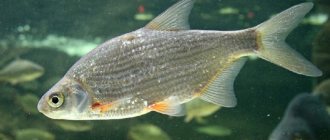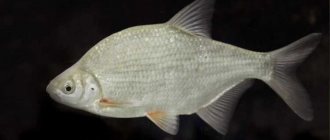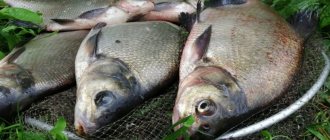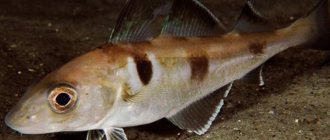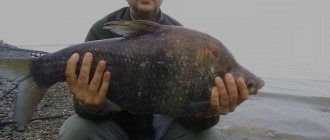Who is this bream?
Gustera is a carp fish. As a rule, it lives in schools and is similar to bream.
Habitats
This type of fish is common in the waters of the Caspian, Baltic and Black Seas. Also, silver bream can be caught in ponds and small rivers with a slow current and considerable depth.
As statistical data show, this breed of fish actively reproduces in reservoirs and backwaters, where a clay bottom with silt admixtures predominates. The largest individuals are found at depth and in flat sections of rivers, and small silver breams live in shallow water among thick thickets.
Characteristic features of the silver bream
Perhaps one of the most important and pleasant features for fishermen is that silver breams live and breed in flocks. Moreover, the schools are always quite large, which increases the chances of coming home with a serious catch.
The ideal time to catch this fish is morning or afternoon, as it practically cannot see in the dark.
Gustera has:
- tall body, flattened laterally;
- small but noticeable hump;
- notched caudal fin with identical blades along the length;
- thick, tight-fitting scales;
- small head;
- medium sized eyes;
- oblique mouth, which extends in the form of a tube;
- a keel behind the fins that is not covered with scales;
- bluish-gray color (during spawning, males develop white protrusions on their heads, and their fins acquire a more pronounced color).
The meat of the bream is bony and does not have a pronounced taste. Biological scientists classify this breed as a low-value commercial breed.
Taste characteristics
The bream is the most common fish in fishing. Found in many bodies of water, of reasonable size and valued for its taste. It is used in cooking in various ways: fried in a frying pan, baked in foil and on coals, salted. Also common in dried form as a beer snack. More often than not, this type of fish weighs less than a kilogram and is easy to prepare.
Gustera is distinguished by meat that is fattier and richer in taste.
, especially in large individuals. The fish tastes good when dried or fried. It can also be served baked in foil, retaining all its beneficial properties. Quite easy to clean due to large scales.
So, let's summarize and repeat the above.
For those new to fishing, it will be useful to remember several significant differences between the silver bream and the white bream, so that later you can accurately determine who is who. This is often not easy to do because of the similar habitat of these two fish, because of their similar lifestyle (both species of fish gather in schools and love dark places in the pond) and similar appearance (body shape and scale color). But, knowing the main differences between these two fish, you can easily determine which one you caught.
- Silver bream, unlike bream, is of insignificant size.
- The mouth of the silver bream is elongated into a tube, while that of the white bream is not elongated.
- The silver bream has more teeth and is in two rows.
- You can distinguish the fish by its anal and caudal fins.
- The scales of the silver bream are larger than those of the white bream.
- The white bream has a lot of mucus on its body, while the silver bream has almost none.
- The eyes of the silver bream are noticeably larger than those of the white bream.
The silver bream, unlike the white bream, comes out to feed all day long. The bite can actively continue for about two hours. When feeding, the breams take breaks for a day and feed in batches. The silver bream is very active in this regard and can even drive away and outstrip bream when feeding. Both fish are similar in character: lazy, calm, love thickets and keep in schools, they are inhabitants of the bottom layers of reservoirs, most often rivers.
So, let's summarize. Visible at first glance differences between the hummers are as follows:
:
- A blunter nose.
- Blue tint on the scales. The scales of bream are simply silvery.
- And, of course, red/pink fins.
We hope our review article helped you. Good luck with your fishing and recreation.
No matter how surprising it may be, not every experienced fisherman knows the difference between the silver bream and the white bream; the differences between these fish are so minimal that it is really very easy to confuse them. Many fishermen, when receiving such a catch, find it difficult to answer which particular river representative was hooked. Ichthyologists claim that the external similarity of these fish is simply colossal, and they are found in the same area. Nevertheless, if you have certain knowledge, it is still possible to distinguish these fish.
Gustera is a representative of the carp family. The fish looks very similar to bream and usually lives in schools. Catching a silver bream today is not at all difficult, since these fish are found in the Black, Baltic, and Caspian Seas. They can also be found in small reservoirs and rivers with weak currents, but with great depth. Experts warn that if a fisherman plans to catch a truly valuable trophy, he will have to fish at great depths, since large representatives prefer to live there. As for shallow waters, only medium-sized fish can be found in such areas.
The silver bream differs from the white bream and other fish in that it lives and reproduces in schools. This feature of behavior plays into the hands of fishermen, since schools, as a rule, are distinguished by a large number of individuals, which greatly increases the chances of a successful catch. The difference between the silver bream and the white bream is also that this fish practically cannot see in the dark, so you need to catch it during the day or early in the morning.
The silver bream can also be identified by the following external signs:
- the fish has a rather high body, which is strongly compacted on the sides;
- mature individuals have a small hump on their back;
- the body of the fish is covered with dense and thick scales, which have a bluish color;
- The head of the silver bream is quite small, the eyes are also small;
- the fin is equipped with identical blades along its length;
- behind the fins of males and females there is a keel on which scales are completely absent.
It’s worth noting right away that these river representatives are not valuable. The meat of these fish does not have a pleasant taste and has many small bones, so the silver bream is classified as a commercial species.
Despite the fact that silver bream and bream are very similar in appearance, white bream are still considered good fish, which are consumed in a variety of forms. This fish is very common in fresh water bodies and is not particularly whimsical, so it can be caught in almost any lake or river. An important difference between the silver bream and the bream is that the bream does not like sunlight, therefore it leads a predominantly nocturnal lifestyle. To catch a half-kilogram white bream, you will have to go fishing in the late afternoon, or even better, after midnight. Unlike silver bream, bream are quite smart and timid, so catching them may not be so easy.
These river representatives prefer to live in various depressions and holes and have the following external characteristics:
- the body is quite high, but flattened at the sides;
- in adults there are 10 pharyngeal teeth in the mouth;
- Breams have a very small head, but rather large eyes;
- The color of the fish is silver with a white tint;
- Closer to the belly, the scales of the bream become reddish.
The differences also lie in the fact that bream has very tasty and tender meat, containing a large amount of useful vitamins and valuable minerals. But it’s worth saying right away that bream also has a lot of bones.
If a fisherman caught a fish on the shore, but finds it difficult to say who exactly he caught, experts advise paying attention to some points that will definitely help determine the catch.
How to distinguish these river representatives:
- Size and shade of fins. The dorsal fin of the silver bream has 8 ornate and 3 simple rays. The unpaired fins of the fish have a grayish tint, and the paired fins are reddish. All fins of breams are light gray, darkening towards the end.
- Head. The silver bream has a blunt head shape, while the bream has a more coal-shaped head.
- The scales of the silver bream are much larger than those of the white bream and adult bream.
- Taste features. If you fry or boil freshly caught bream, the meat will be surprisingly tender and tasty. Not every fisherman likes to eat gustera.
Despite the fact that the silver bream and the white bream, the differences of which have long been known, live in the same bodies of water, these river representatives still differ significantly from each other. In almost all countries of the world, bream is considered a valuable fish, but silver bream is often used only for the production of canned food.
Gustera is a representative of peaceful fish species of the carp family, which is one of the most common in our reservoirs. This fish can be found in any river, reservoir, lake and even small city canals and ponds. In general, the habitat of the silver bream is very wide. It can be found in the basins of the Black, Azov and Caspian seas. In Ukraine, the silver bream is absent only in the reservoirs of the Crimean peninsula.
It has a tall body that is strongly flattened at the sides. The entire body of the fish is covered with large, dense scales. The dorsal fin is gray in color and has a high, sharp shape. The caudal and anal fins of the silver bream are also gray. The pelvic and pectoral fins have a yellowish or reddish tint. The silver bream has a silvery color, the back of the fish is gray-blue. The fish's mouth is small, its eyes are large.
Under good living conditions, the silver bream can grow up to 1.2 kg, but such specimens are found extremely rarely and mainly in large reservoirs. On average, the silver bream reaches 30 cm in length and weighs up to 600-800 grams. For most fishermen in Ukraine who catch silver bream, fish sizes ranging from 50 to 400 grams are common.
Many fishermen note the special taste of dried silver bream, which is why it is highly valued by beer lovers.
Spawning of silver bream begins in early May, at a water temperature of +12 degrees. The fish spawns in shallow water areas, in bays and creeks without a current. Before spawning, the male silver bream acquires a nuptial coloration, which is characterized by the appearance of tubercles in the upper part of the fish’s body and on its head.
Habitats
As mentioned above, silver bream is a fairly widespread fish species. Therefore, it can be found in almost any body of water. Probably the only place where the silver bream does not live is peat quarries and swampy reservoirs without a current, heavily overgrown with aquatic vegetation.
Large specimens of silver bream prefer deeper areas of reservoirs with slow currents. Their habitats are usually completely devoid of any vegetation. Also, flocks of large silver bream can often live in places favored by bream. Moreover, the fish get along quite well with each other.
Small silver bream chooses shallow areas with sparse vegetation on the bottom. These can be various creeks, bays, backwaters and oxbow lakes. It can also be found in deeper areas of the current, where there are at least some bottom shelters.
White bream is a schooling fish that leads a sedentary lifestyle. The fish migrates only before spawning and before freeze-up. The rest of the time the silver bream spends in its usual places, actively feeding and gaining weight.
How to catch silver bream
The silver bream is a bottom-dwelling peaceful fish that feeds mainly on bottom invertebrates and small crustaceans. They catch silver bream in different ways, using maggots, worms, bloodworms, and steamed wheat as bait. The main methods of catching silver bream are:
- Feeder and picker.
- Fly fishing rod (revving, with long casting, etc.)
- Bottom rigs.
- In winter, use jigs and streams.
White bream and white bream: differences
At first glance, these two fish are very similar and not all anglers, especially beginners, can distinguish a silver bream from a white bream. So, let’s list the main differences between these fish:
- The silver bream has large bulging eyes.
- The anal fin of the bream is longer and has 25-29 rays, while the silver bream has only 19-24.
- The scales of the silver bream are larger than those of the white bream.
- The silver bream has double-rowed pharyngeal teeth, while the white bream has single-rowed teeth.
- The ventral and pectoral fins and silver breams have a yellowish tint, and sometimes almost red, when in bream they are gray.
Fish that look similar to each other are not uncommon. It is important for a professional fisherman to distinguish fish, even if they are from the same family.
Who is a scavenger?
A bream is a well-known bream that has not formed at the time of catching, i.e. young animals There is no exact definition for its weight, since some fishermen include bream whose weight has not reached 500 grams, and others - 1.5 kg.
Habitats
The white bream lives in all rivers of the Russian Federation that are not characterized by high flow rates. The white bream is also found in the waters of the Black, Caspian, and Azov seas. Often this breed of fish can be found in brackish water areas.
Characteristic features of breams
The main distinguishing feature of breams is the time they are caught. This fish does not like daylight, so the ideal time to catch it is at night.
Just like silver breams, white breams are found in flocks. It would seem that catching it couldn’t be easier, but this is a misconception. This breed of fish is too smart and careful; catching it means really winning. Breeders overwinter in deep places, holes and pools.
They have:
- tall body, usually 1/3 of the total length, flattened at the sides;
- long anal fin;
- 5 pairs of pharyngeal teeth;
- small mouth and head;
- big eyes;
- darker fin color than bream;
- silver-white color;
- reddish tint in the belly and throat area.
The meat of both bream and bream is rich in vitamins and beneficial microelements. In terms of taste, it is soft, tender, but bony.
How to catch more fish?
I have been active fishing for quite some time and have found many ways to improve the bite. And here are the most effective:
- Bite activator. Attracts fish in cold and warm water with the help of pheromones included in the composition and stimulates its appetite. It’s a pity that Rosprirodnadzor wants to impose a ban on its sale.
- More sensitive gear. Reviews and instructions for other types of gear can be found on the pages of my website.
- Lures using pheromones.
You can get the rest of the secrets of successful fishing for free by reading our other articles on the site.
Other Important Points
Bream and bream are considered one of the most common fish that many anglers “hunt”. The main feature is that this subspecies can be found in almost any river. Given the special taste of fish, it is served in many expensive restaurants, baked over coals, in the oven, steamed, etc.
d. Dried bream is in particular demand. The fish meat is tender and lean, which cannot be said about the silver bream.
It should be noted that, despite all of the above, perhaps not everyone will be able to immediately learn to distinguish one fish from another, but over time, with practice, everything will work out on its own. In addition to those points that have been presented, it must be said that it is important to pay attention not only to the appearance of the fish, but also to the characteristics of its behavior. White breams come for bait intermittently, which cannot be said about the silver bream. At the same time, you won’t find others at night.
You can judge what an average adult bream looks like by its image in the picture.
The anal fin of the fish is approximately twice as long as the dorsal fin. The tail of the bream is dark in color with a wide cut at the end on both sides and takes on a pointed shape. In terms of body color, bream generally looks like a silver-colored fish, although the tone of its scales largely depends on age and habitat. In a favorable environment, bream grows up to several kilograms in weight, acquiring a darker color.
Small immature bream among fishermen have received the purely conventional name “bream”, although Russia is full of small reservoirs where, due to the meager food supply, bream even at 5-6 years of life look the same as their juveniles in large rivers rich in food.
[custom_ads_shortcode2]
How to distinguish a silver bream from a white bream
Not only for a novice fisherman, but also for an experienced professional, it is sometimes difficult to distinguish a silver bream from a white bream, since these two species of fish have too many similar features.
In the teeth. It’s quite easy to determine which fish is in front of you by its teeth: the silver bream has 7 teeth, which are arranged in 2 rows. The white bream has 5 teeth located on each side in one row.
To taste. The white bream, as noted earlier, has soft and tender meat, which is quite lean. The taste is pronounced. Ideal for smoking. Gustera has fattier meat and a less rich taste. But it can also be used for smoking or frying.
By color and shape of fins. The silver bream has eight branched and three simple rays in the dorsal fin, as well as 24 branched and 3 simple rays in the anal fin. This is its distinctive feature. All of its paired fins are colored red, and unpaired fins are gray.
The white bream has a longer anal fin, consisting of 30 rays. It originates from the dorsal and has a light gray color. The reddish color of this fish is visible only on the belly or at the base of the throat.
According to the shape of the head. Gustera has a blunt head shape. Her eyes are large, usually cast iron in color, and her pupils are large. The white bream has a pointed head, its dorsal hump rises steeply, but its shape is more round than that of the silver bream.
By the tail. If both fin feathers are rounded inside, then it is a silver bream. The white bream's upper feather is shorter than the lower one. Also, the cutout of its fin is at a right angle.
By scale size. The silver bream is covered with rather large scales.
Its quantity for the entire body is no more than 13 pieces. In the white bream it is of medium size, ranging from 12 to 18 pieces.
Method of catching silver bream
Experienced fishermen advise adhering to the following rules if you are going to hunt silver bream:
- Use a fly rod and a light float.
- The thickness of the fishing line can be chosen at your own discretion.
- A sliding sinker is ideal, and hooks should be taken in the range from 14 to 18 numbers according to the international classification.
Please note that the length of the leash should not exceed 15 cm.
Many fishermen also advise using a feeder and donka. Before using it, it is necessary to examine the river bottom, namely, study:
- depth;
- speed of the current;
- drops and depressions.
To make the fishing process easier, you can use a weight with spikes. Once you locate the rock bottom, lower your rod, clip in, and start hunting.
Depending on the time of year, there are certain fishing recommendations:
- In winter, it is recommended to catch silver bream using thin equipment. Considering that during this period of time the fish is less active, the size of the jig should not exceed the size of a match head.
- In the spring, you should look for the silver bream in river mouths, large backwaters and bays. Remember that after hibernation the fish begin to actively hunt for food. Try to sail as far as possible.
- The most active biting of the silver bream begins in June - by this time the fish have already finished spawning. You don’t have to swim far, because during this period of time the water warms up completely, so catching fish from the shore will not be a problem.
- If you go out for the silver bream in the fall, then you should sail further away. After all, the water begins to cool again, and the fish begin to look for warm places to winter. It is most effective to use a stationary bait.
Breeding conditions - bream spawning
Spawning during the breeding periods of bream at different latitudes of Russia is shifted in time and is possible if certain conditions are met.
The bream begins to spawn at the age of 4-5 years. When breeding, a female bream, depending on its size, can spawn from several tens of thousands to half a million eggs.
The sizes of bream ready for spawning in different reservoirs are not the same and depend on the conditions of existence in the habitat. The fertility of fish increases with age, but several conditions must be met to begin the reproduction process:
Spawning of bream gathered in a large school begins according to age groups, but at a water temperature of not lower than 12-14 degrees. The smaller breams breed first.
Reproduction of large bream can begin generally when the water warms up to 20-22 degrees. Therefore, during the spawning period, fishermen have a very short period of time to catch a bream meal without biting small things.
Another condition for bream to begin breeding is the presence of a suitable place within the reservoir.
For spawning, bream choose areas of reservoirs with a depth of 20-30 centimeters to several meters with a weak or no current. During the breeding season of any age group, it is better to forget about catching spawning fish.
As a rule, eggs are deposited in meadows flooded during floods, in river floodplains, on the roots of shrubs, on the stems of reeds, reeds, and on fresh green vegetation in the bed of a reservoir. When the water recedes, some of the eggs disappear.
During the breeding season, males (not only bream) are covered with nuptial plumage; the ends of their scales extend from their bodies, which is why the fish becomes rough to the touch.
After spawning, bream go to their permanent habitats, from where they periodically move to feed in areas rich in food.
The conditions and time for adaptation of fish after reproduction is about a week and depends on the weather and the condition of the reservoir. Then fishermen begin to catch the first bream that noticeably lose weight after spawning.
Silver bream and bream (bream) are two fish that novice fishermen always confuse. In fact, the two species are incredibly similar to each other, so it may not be immediately clear who is who. Despite the fact that these are different fish, they both belong to the carp family. In addition, both bream and silver bream live in the same reservoirs; they have approximately the same size, as well as the color of their scales.
The surprising thing is that the silver bream can adapt to the conditions in which it lives, and this additionally affects its resemblance to the white bream. If two individuals live in the same river, then even an experienced fisherman can find it difficult to understand how one fish differs from the other.
In order to distinguish silver bream from bream, it is necessary to carefully study these two species of waterfowl.
A young specimen of bream, which is familiar to all fishermen, is called a bream. The color of this species directly depends on the age of the fish, as well as its habitat. Young breams often have gray-silver scales, which change to golden in color with age. Bream can usually be found in the thickets, it stays with its “brethren” in a small flock. Fishermen note that these fish species are quite careful and intelligent.
In winter, the bream can be found in deep water, in various depressions and crevices.
The difference between the silver bream is, first of all, that it is more difficult to find in reservoirs, because it is less common in them. This is not a “loner” fish, so the presented subspecies always swim in large schools.
Gustera is always more active in feeding. At the same time, sometimes you cannot lure bream even with the most “appetizing delicacies”. With age, the scales of the silver bream do not change their color, remaining bright gray.
Although there is still a difference, it is not significant, but it is there.
Useful tips for fishing
If you decide to go hunting for this type of fish, then take note of the following nuances:
- you need to have a lot of bait with you, since the silver bream is a very voracious fish, especially when it is in a school or during spawning;
- take bloodworms, pink, peas, millet, corn; in the warm season, you can add a little sweet syrup, crackers or molasses to the bait;
- jigs can be used in various shapes, types, sizes and colors;
- when selecting the thickness of the fishing line, you should still opt for denser specimens;
- be prepared for active fishing, because... the silver bream is a wild and courageous breed;
- The catch should be stored in cages made of nylon or wire mesh. For longer storage, it is recommended to use a tarp.
Having studied all the main differences, methods and features of fishing, you can easily catch a silver bream. Enjoy fishing, please yourself and your loved ones with a rich catch!
